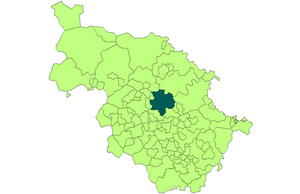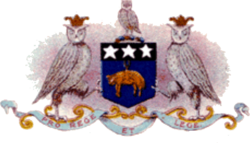| City of Leeds County Borough of Leeds | |
|---|---|
 Leeds Town Hall | |
 Leeds shown within the West Riding in 1971 | |
| Area | |
| • 1911 | 21,593 acres (8,738 ha) |
| • 1931 | 38,105 acres (15,421 ha) |
| • 1961 | 40,612 acres (16,435 ha) |
| Population | |
| • 1911 | 445,550 |
| • 1931 | 482,809 |
| • 1961 | 510,676 |
| Density | |
| • 1911 | 21/acre |
| • 1931 | 13/acre |
| • 1961 | 13/acre |
| History | |
| • Origin | Leeds ancient borough[1] |
| • Created | 1836 |
| • Abolished | 1974 |
| • Succeeded by | City of Leeds (metropolitan district) |
| Status | Municipal borough (1835–1889) County borough (1889–1974) City (1893–1974) |
| Government | |
| • HQ | Leeds |
| • Motto | PRO REGE ET LEGE |
 Coat of arms in use until 1921 | |
The County Borough of Leeds, and its predecessor, the Municipal Borough of Leeds, was a local government district in the West Riding of Yorkshire, England, from 1835 to 1974.[2] Its origin was the ancient borough of Leeds, which was reformed by the Municipal Corporations Act 1835. In 1889, when West Riding County Council was formed, Leeds became a county borough outside the administrative county of the West Riding; and in 1893 the borough gained city status. The borough was extended a number of times, expanding from 21,593 acres (8,738 ha) in 1911 to 40,612 acres (16,435 ha) in 1961; adding in stages the former area of Roundhay, Seacroft, Shadwell and Middleton parishes and gaining other parts of adjacent districts. In 1971 Leeds was the fifth largest county borough by population in England. The county borough was abolished in 1974 and replaced with the larger City of Leeds, a metropolitan district of West Yorkshire.
- ^ Great Britain Historical GIS / University of Portsmouth, Leeds ancient borough. Retrieved 16 September 2009. Archived 25 December 2012 at archive.today
- ^ Great Britain Historical GIS / University of Portsmouth, Leeds MB/CB. Retrieved 16 September 2009.